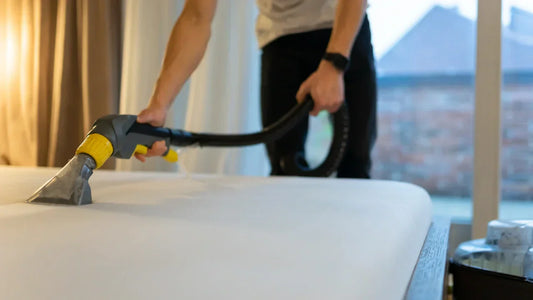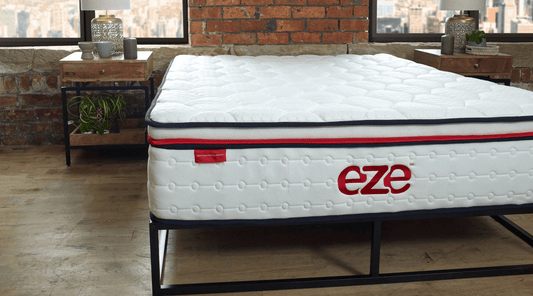Waking up with back pain? You're not alone.
Many of us are on the hunt for ways to ease those aches, and a common question pops up: "Is memory foam good for your back?"
The short answer is: yes, memory foam can be good for back pain.
But not every memory foam mattress is made equal.
In this guide, we’ll show you how memory foam can help back pain, and how to find the right mattress for you and your back.
Is Memory Foam Good for Back Pain?
-
Yes, when it offers medium to firm support
-
Helps with spinal alignment and pressure relief
-
May not help if the foam is too soft or of poor quality
-
Hybrid designs often offer the best balance
What causes back pain when you sleep?
Generally, a lack of support is the main culprit for back pain.
If your mattress isn't providing adequate support or is causing your spine to curve unnaturally, you're likely to feel it in your back.
But replacing your mattress may not completely resolve the issue, as there are other factors that can impact back pain, including:
-
Lack of Pillow Support: Your pillow plays a big role in keeping your neck and spine aligned. The wrong height or firmness can throw things out of whack.
-
Sleeping Position: Sleeping in an awkward position can put stress on your spine, which can lead to back pain.
-
Existing Health Conditions: Sometimes, underlying health issues can be the source of or contribute to back pain.
How does memory foam help with back pain?
So, why is memory foam often recommended for those with back pain?
Amazing Pressure Relief
Memory foam is famous for its ability to contour to your body shape.
This helps to distribute your weight evenly, leading to reduced pressure on sensitive areas like your hips, shoulders, and lower back.
Less pressure can mean less tossing and turning, and a more restful sleep.
Promotes Spinal Alignment
When you sink into memory foam, it can help keep your spine in a more neutral position.
The right memory foam, when correctly layered and supported, helps maintain the natural curves of your spine, preventing awkward contortions that lead to pain.
Support Where You Need It
Good quality memory foam doesn’t just let you sink; it also provides a supportive feel, especially when integrated into a hybrid design.
This combination prevents the hammock effect you might get with a mattress that’s too soft or lacks a strong core, which can be a real trigger for memory foam mattress back problems.
When might memory foam cause back pain?
While memory foam as a material offers many benefits, there are times when a mattress incorporating it may not provide relief, or could even contribute to back pain.
This usually boils down to a few things:
Too Soft
This is the big one.
If a memory foam mattress is too soft for your body weight or sleeping style, or lacks a robust support core, you might sink in too deeply.
This can lead to pain and strain because it causes your spine to curve unnaturally, which is a common reason for a sore back.
Lack of Overall Support from the Core Mattress Structure
Sometimes, it's not just the memory foam layer itself but the entire mattress construction or the base it's on.
If the mattress lacks a supportive core, even the best memory foam won't be able to do its job properly.
This is less of a concern with well-designed hybrid mattresses, like those from eze™, where the dynamic spring layer provides additional support for the memory foam layer.
Low-Quality Foam
Cheaper, lower-density memory foam might feel good initially, but can break down more quickly, losing its supportive qualities and leading to back issues over time.
Tips for choosing the right memory foam mattress for back pain
Ready to find a mattress that loves your back? Here’s what to keep in mind:
Consider the Firmness Rating
Generally, medium and firm mattresses are seen as the best for back support as they keep your spine aligned and in a natural position. However, this heavily varies depending on brand, with some soft mattresses providing better support than firmer alternatives. Take our award-winning eze™ Hybrid Ultra and eze™ Hybrid Max mattresses. While soft, ‘Which?’ rated both as providing excellent support and durability. Our advice is to read up on reviews and trying any mattresses before you buy to see if it’s the right fit for you.
Consider Your Sleeping Position
Side sleepers often benefit from a mattress with a slightly softer comfort layer over a supportive core, which helps cushion their hips and shoulders.
Back and stomach sleepers typically require a medium-firm to firm overall feel to maintain spine alignment.
Consider Your Body Weight
Heavier individuals typically require a firmer, more supportive mattress, while lighter individuals may find a slightly softer feel (still with good underlying support) more comfortable.
Check the Comfort Layer Thickness and Quality
A well-proportioned comfort layer of high-quality memory foam can offer excellent cushioning.
But it’s important to check it's balanced with a supportive core, such as the pocket spring system in a hybrid.
Don’t Forget the Base
Ensure your bed base is solid and supportive.
A sagging base will undermine even the best mattress.
Could It Be Something Else?
Remember, while a mattress can make a significant difference, back pain may have other causes.
It's always a good idea to consult with a doctor or physiotherapist if your back pain persists.
Memory foam vs other mattress types for back pain
How does memory foam stack up against other options for back pain sufferers, and where do hybrids fit in?
Pocket Sprung Mattresses
Traditional pocket-sprung mattresses can also be good for back pain, especially if they offer zoned support.
The springs provide bounce and support.
However, without a comfortable top layer, some might find them too firm or less able to contour to the body compared to mattresses incorporating memory foam.
Hybrid Mattresses: The Best of Both Worlds?
Hybrid mattresses, like our award-winning eze™ mattresses, combine the supportive benefits of pocket springs with the contouring comfort of memory foam on top.
This means you can get the responsive, deep-down support your spine needs from the springs, plus the targeted pressure relief and alignment help from the memory foam layers.
For many people with back pain, a well-crafted hybrid truly offers an ideal balance.
Apart from firmness, what other mattress features should I look for if I have back pain?
Firmness is crucial, but other features can make a big difference too!
Zoned Support
Some advanced mattresses feature zoned support systems.
This means different areas of the mattress offer varied levels of firmness and support.
For example, it might be firmer in the lumbar region where your lower back needs it most, and slightly softer around the shoulders and hips.
This targeted support can be fantastic for spinal alignment and relieving back pain.
Edge Support
Good edge support means the sides of the mattress are sturdy and don't collapse when you sit on the edge or sleep near it.
This not only increases the usable sleeping surface but also makes getting in and out of bed easier, which can be a significant benefit if you experience back stiffness.
It also prevents that 'rolling off' feeling.
Motion Isolation
If you have a sleeping partner, a mattress with good motion isolation (where movement on one side doesn't transfer to the other) can prevent your partner's tossing and turning from disturbing your sleep and potentially aggravating your back.
Both high-quality memory foam and hybrid mattresses often excel at this.
Breathability/Cooling Features
Although not directly related to support, excessive heat can lead to restless sleep, which in turn doesn't help alleviate back pain.
Look for mattresses with cooling gels, breathable covers, or open-cell foam structures if you're a hot sleeper.
For instance, models from our Cooleze™ collection, like the Cooleze™ Hybrid Platinum Mattress, Cooleze™ Hybrid Deluxe Mattress and the Cooleze™ Hybrid Original Mattress, incorporate cooling gel alongside supportive memory foam.
Considering these features alongside the right firmness can help you find a mattress that truly supports your back and contributes to a much more comfortable night's sleep.
More Answers to Your Back Care Questions
We know that when your back is bothering you, you want all the information you can get!
Here are a few more common questions answered:
How long does it take for your back to adjust to a new memory foam mattress?
This is a great question!
Just like a new pair of supportive shoes, your body might need a little time to get used to a new mattress.
This is true whether it's an all-foam or a hybrid mattress incorporating memory foam.
For some people, the comfort and relief are immediate.
For others, it might take anywhere from a few nights to a few weeks for their body (and back!) to fully adapt to the new level of support and pressure relief.
During this adjustment period, you might even feel a little different, perhaps noticing muscles you haven't felt in a while as your spine aligns correctly.
Can memory foam make existing back problems worse?
It's a valid concern. The good news is that a suitable mattress incorporating high-quality memory foam is unlikely to exacerbate existing back problems and often provides significant relief.
However, if you choose a mattress that’s too soft or doesn’t suit your sleeping position, you could potentially exacerbate some back issues.
What density of memory foam is best for back support?
Foam density plays a big role in the support and durability of a memory foam layer.
This is measured in pounds per cubic foot (PCF) or kilograms per cubic metre. Generally, for good back support and longevity, look for a memory foam mattress with a medium to high density.
-
Lower-density foams (e.g., below 3 PCF or 48 kg/m³) might feel softer and be more budget-friendly, but they may not offer as much support over time and could break down more quickly.
-
Medium-density foams (e.g., around 3 to 5 PCF or 48-80 kg/m³) often provide a good balance of comfort, support, and durability, making them a popular choice for many, including those with back pain.
-
Higher-density foams (e.g., above 5 PCF or 80 kg/m³) are typically very supportive and durable, but they can also feel firmer and might retain more heat unless they have cooling features.
Can a memory foam mattress topper help with back pain if I can't replace my whole mattress?
Yes, a good quality memory foam mattress topper can be a helpful temporary solution if your existing mattress is too firm and causing pressure points, or if you're looking to add a bit more cushioning and contouring.
A topper can help somewhat by providing an extra layer of pressure relief.
However, it's important to remember that a topper is a 'top-up', not a total fix.
If your underlying mattress is old, sagging, or fundamentally unsupportive, a topper won't magically correct these major issues.









